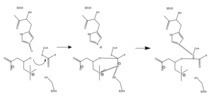Entrez 1384 | Ensembl ENSG00000095321 | |
 | ||
External IDs MGI: 109501 HomoloGene: 598 GeneCards: CRAT | ||
Carnitine O-acetyltransferase also called carnitine acetyltransferase (CRAT, or CAT) (EC 2.3.1.7) is an enzyme that encoded by the CRAT gene that catalyzes the chemical reaction
Contents
- Nomenclature
- Structure
- Active site
- CoA binding site
- Carnitine binding site
- Enzyme mechanism
- Biological function
- Clinical significance
- Interactions
- References
where the acetyl group displaces the hydrogen atom in the central hydroxyl group of carnitine.
Thus, the two substrates of this enzyme are acetyl-CoA and carnitine, whereas its two products are CoA and O-acetylcarnitine. The reaction is highly reversible and does not depend on the order in which substrates bind.
Different subcellular localizations of the CRAT mRNAs are thought to result from alternative splicing of the CRAT gene suggested by the divergent sequences in the 5' region of peroxisomal and mitochondrial CRAT cDNAs and the location of an intron where the sequences diverge. The alternatively splicing of this gene results in three distinct isoforms, one of which contains an N-terminal mitochondrial transit peptide, and has been shown to be located in mitochondria.
Nomenclature
This enzyme belongs to the family of transferases, to be specific those acyltransferases transferring groups other than aminoacyl groups. The systematic name of this enzyme class is acetyl-CoA:carnitine O-acetyltransferase. Other names in common use include acetyl-CoA-carnitine O-acetyltransferase, acetylcarnitine transferase, carnitine acetyl coenzyme A transferase, carnitine acetylase, carnitine acetyltransferase, carnitine-acetyl-CoA transferase, and CATC. This enzyme participates in alanine and aspartate metabolism.
Structure
In general, carnitine acetyltransferases have molecular weights of about 70 kDa, and contain approximately 600 residues1. CRAT contains two domains, an N domain and a C domain, and is composed of 20 α helices and 16 β strands. The N domain consists of an eight-stranded β sheet flanked on both sides by eight α helices. A six-stranded mixed β sheet and eleven α helices comprise the enzyme’s C domain.
When compared, the cores of the two domains reflect significantly similar peptide backbone folding. This occurs despite the fact that only 4% of the amino acids that comprise those peptide backbones corresponds to one another.
Active site
His343 is the catalytic residue in CRAT. It is located at the interface between the enzyme’s C and N domains towards the heart of CRAT. His343 is accessible via two 15-18 Å channels that approach the residue from opposite ends of the CRAT enzyme. These channels are utilized by the substrates of CRAT, one channel for carnitine, and one for CoA. The side chain of His343 is positioned irregularly, with the δ1 ring nitrogen hydrogen bonded to the carbonyl oxygen on the amino acid backbone.
CoA binding site
Due to the fact that CRAT binds CoA, rather than acetyl-CoA, it appears that CRAT possesses the ability to hydrolyze acetyl-CoA, before interacting with the lone CoA fragment at the binding site. CoA is bound in a linear conformation with its pantothenic arm binding at the active site. Here, the pantothenic arm’s terminal thiol group and the ε2 nitrogen on the catalytic His343 side chain form a hydrogen bond. The 3’-phosphate on CoA forms interactions with residues Lys419 and Lys423. Also at the binding site, the residues Asp430 and Glu453 form a direct hydrogen bond to one another. If either residue exhibits a mutation, can result in a decrease in CRAT activity.
Carnitine binding site
Carnitine binds to CRAT in a partially folded state, with its hydroxyl group and carboxyl group facing opposite directions. The site itself is composed of the C domain β sheet and particular residues from the N domain. Upon binding, a face of carnitine is left exposed to the space outside the enzyme. Like CoA, carnitine forms a hydrogen bond with the ε2 nitrogen on His343. In the case of carnitine, the bond is formed with its 3-hydroxyl group. This CRAT catalysis is stereospecific for carnitine, as the stereoisomer of the 3-hydroxyl group cannot sufficiently interact with the CRAT carnitine binding site. CRAT undergoes minor conformational changes upon binding with carnitine.
Enzyme mechanism
The His343 residue at the active site of CRAT acts as a base that is able to deprotonate the CoA thiol group or the Carnitine 3’-hydroxyl group depending on the direction of the reaction. The structure of CRAT optimizes this reaction by causing direct hydrogen bonding between the His343 and both substrates. The deprotonated group is now free to attack the acetyl group of acetyl-CoA or acetylcarnitine at its carbonyl site. The reaction proceeds directly, without the formation of a His343-acetyl intermediate.
Biological function
There is evidence that suggests that CRAT activity is necessary for the cell cycle to proceed from the G1 phase to the S phase.
Clinical significance
Those with an inherited deficiency in CRAT activity are at risk for developing severe heart and neurological problems.
Reduced CRAT activity can be found in individuals suffering from Alzheimer’s disease.
CRAT and its family of enzymes have great potential as targets for developing therapeutic treatments for Type 2 diabetes and other diseases.
